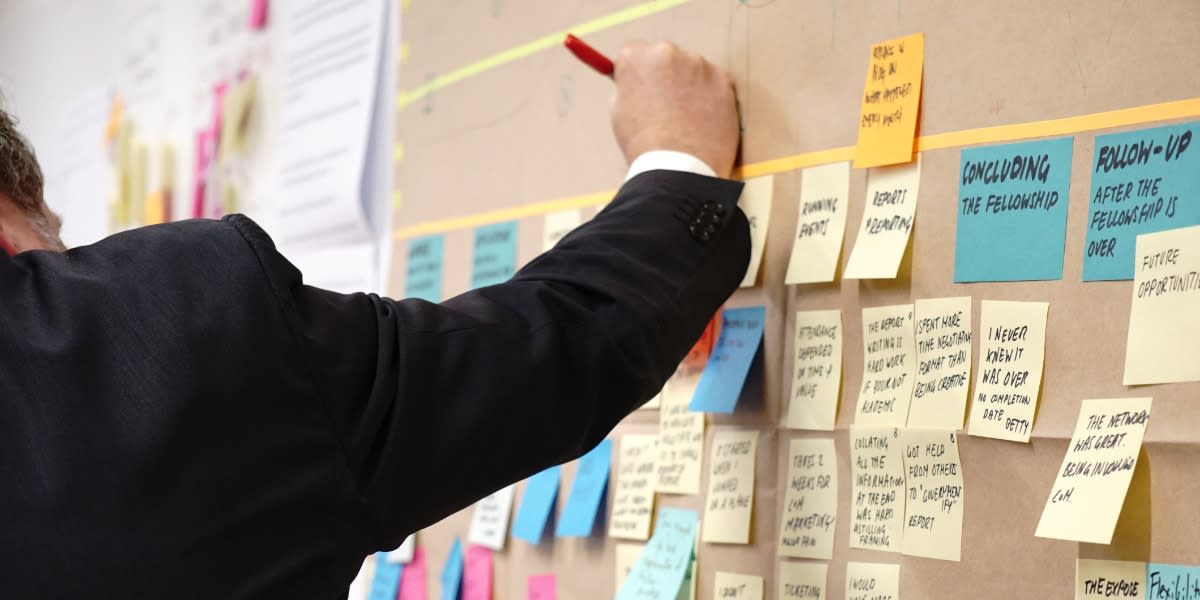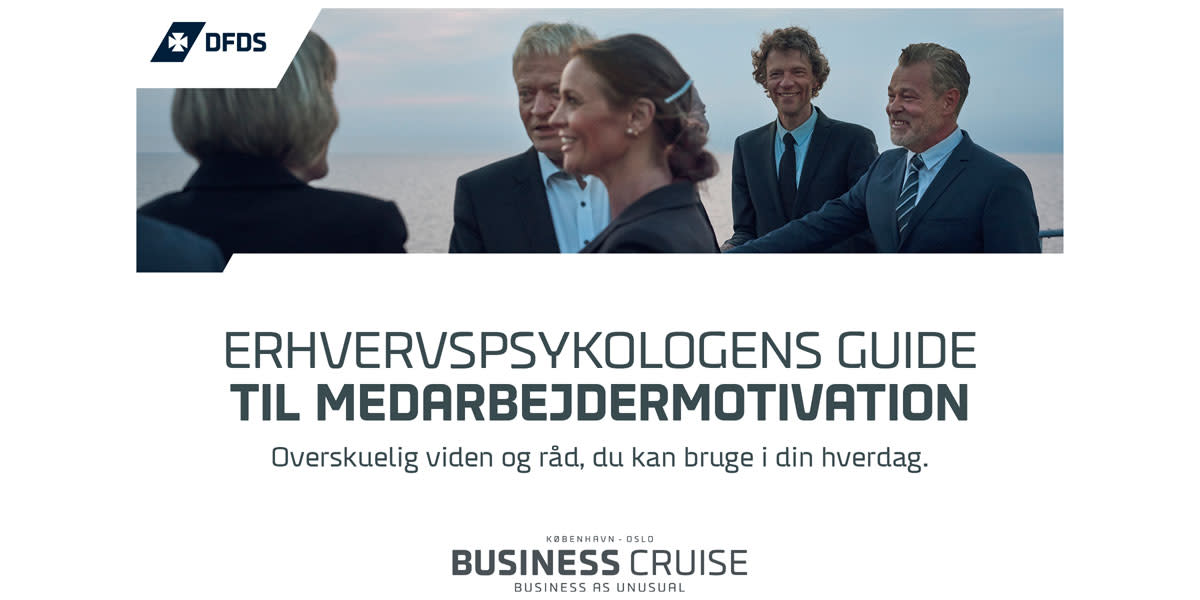
The complete guide: how to create a workshop that yields results
According to the Harvard Business Review, one of the world's most recognized business media, business globally spends more than $ 350 billion a year on skills development and workshops. Nevertheless, 75 per cent. of business leaders dissatisfied with the return on their investment.
Effective workshops are a unique work tool. They activate ideas and solutions that would otherwise be overlooked. Therefore, companies must not give up on the format. Instead, they should focus on holding workshops that yield results.
Workshops that give results, however, require a thoroughly tested method. We want to help you get that, which is why we have allied ourselves with an expert. A man with a unique perspective on how to knit an effective workshop together.
Workshops that give results
The name is Kasper Glent-Rolle.
He is first and foremost a chaos pilot and facilitator and has tons of practical experience in arranging and executing workshops that yield results. He is also a scout. For more than 20 years, Kasper Glent-Rolle has been part of the Danish Scout Corps. First as a scout, then in the leadership role for activities and projects with more than 10,000 participants. Among other things, as a project manager at Ungdomsøen, where workshops are one of the most popular work tools.
“The workshop is a format I have always dealt with. Both as a scout and project manager, as a chaos pilot and later professionally. I have the approach to workshops that there should be action. Something needs to happen. But in all cases, workshops for me have been about engaging and involving people on issues and common solutions, ” explains Kasper Glent-Rolle.
We have asked Kasper Glent-Rolle for his recipe for the good workshop. First and foremost, however, we must have the premise in place: What are - according to Kasper Glent-Rolle - the success criteria for workshops that yield results?
“For the good workshop, the participants are immersed and engaged. They invite and have the opportunity to participate. That is the hallmark of a workshop: People participate. Workshops should never be confused with a presentation where you just talk for two minutes with your sidekick, and then it's done ”.
Success criteria for workshops that give results:
- Participants must gain new insights about themselves or a topic
- The participants as a group must reach a common understanding
- Participants must end the workshop with an experience of having arrived at something guiding and relevant. Initiatives that can be implemented in their everyday lives or inputs to a relevant process that are meaningfully lifted further afterwards.
- Participants must feel that their input has made a difference
How can you put together a workshop according to Kasper Glent-Rolle's success criteria? You get the recipe for it right here:
Step 1: Expectation poll
All productive workshops that yield results start with an expectation poll. The foundation will be laid before the workshop itself runs off the stack. The facilitator can advantageously inform the participants a few days in advance so that they have the opportunity to prepare.
The expectations poll concerns many different aspects of the workshop. According to Kasper Glent-Rolle, there are three points in particular that you need to be aware of:
- Delimitation: Exactly what topic should you deal with at the workshop?
- Output: What should you produce at the workshop, and who should produce this output? The participants themselves or the workshop owner or someone else?
- The participants: What should the participants contribute to the workshop?
The last point in particular is often overlooked, and this can have major consequences for the overall benefit of the workshop. For example, it is inappropriate if the participants come up with an expectation that this is such an event, where you passively listen and maybe write a few emails while the presentations are on.
It does not work. Participants must agree that they are on. The more concrete you can become, the better. For example, put into words how the participants should prepare and how they should contribute to discussions, idea development, brainstorm, etc. It should also be clear to the participants why they participate in the role they do.
You can use your choice of location to ensure that the workshop does not just become another meeting in a row. If you are considering moving out of your usual premises, there are many good opportunities. For example, facilities at sea, which research shows have a positive effect on participants' productivity.
Step 2: The content
The substance, the core or the theme. We are at a very central point for the productive workshop:
How should you fill in the time to ensure the best return?
The content is of course dependent on the specific company, but Kasper Glent-Rolle presents here his recipe for the good workshop structure:
- The practical: Space and air are needed. The participants should preferably be able to sit in groups and move around freely. Everyone must have the opportunity to get up. It is not necessarily a requirement, but the facilitator must take into account the space. The groups must be large enough to contain different disciplines and inputs, but small enough for everyone to have a say.
- Open or closed: The facilitator must decide whether you hold a closed workshop or an open workshop.
The closed workshop is characterized by the participants having to find specific solutions to specific problems. The participants are hand-picked and you can design the workshop to their level of knowledge. The exercises always aim at a concrete task solution.
The open workshop is characterized by the participants having to brainstorm and challenge existing frameworks. The participants are a motley assembly with widely differing professional backgrounds and roles in the organization. The exercises constantly aim to generate commitment and new ideas and not necessarily specific solutions to concrete problems.
- Activities: Good workshops support the common understanding and creation process with activities. Kasper Glent-Rolle basically makes three demands on the activities at his workshops: They must be simple, they must be adapted to the target group, and they must very much contain an element of surprise.
“For Civil Society Common Day, I held a workshop with Global Focus and the World's Best News. We did an activity where the participants had to have their hands in a tub of water, while watching a short video on how to dry their hands with the least possible consumption of paper. It was such a little surprising experience for the participants. They were taken out of their comfort zone, but not in a cross-border way. If you can do some activities that the participants can remember and talk about afterwards, it works insanely well, ”explains Kasper Glent-Rolle.
- Why: Participants should never be in doubt about what the purpose of an exercise is. As a facilitator, you must explain exactly why the participants should do a particular exercise and what they should get out of the exercise. If anything is to remain secret, explain why.
Not just right now and here, but in the long run when participants are back in their everyday lives at work.
3 Step: Mirroring to your own reality
If the participants get the impression that the workshop is not going to make any difference back in everyday life, the workshop is doomed. Participants need to understand why the workshop is relevant to me.
That is why it is important to mirror the workshop to your own reality. Whatever you do at the workshop - discussion, idea development, physical activity, etc. - it must be part of a common thread that leads back to the purpose you have set for the workshop.
What are we going to use this for when we get home?
If you develop new working methods at the workshop, you can possibly try them now and here. To qualify the exercises, but also to emphasize that this will influence the participants' everyday lives.
Step 4: Commitment
Before you end the workshop, you must set aside time for collection. You must review the day's output and keep it up to the purpose of the workshop.
Participants must undertake to act in the future:
- What can we bring from today's workshop?
- What is happening now?
- Who does what?
Name the people responsible for ensuring that the output from the workshop is implemented in your daily work routines and task solution. Otherwise you risk losing the entire yield on the floor.
Step 5: Follow-up
After some time, the facilitator must follow up on the workshop and the agreements made at the workshop. This may involve sending out material - for example the conclusions from the workshop - or explaining to the participants what their input has been used for. What did we arrive at at the workshop, and what are the preliminary experiences of translating the benefits of the workshop?
Follow-up is a good opportunity to present new working methods or guidelines developed and adopted in continuation of the workshop.
Do you want to create workshops that give results?
The recipe looks like this:
- Expectations alignment
- The content
- Mirroring to one's own reality
- Commitment
- Follow up
If you follow the five steps, you have the best chance that the workshop will make a concrete difference for the participants and your organization.

To become more skilled at employee motivation, we have teamed up with two of the country's leading occupational psychologists. We have given them a very simple task: Tell about your most effective management tools to create employee motivation in his organization.
You get concrete tools and tools for your work with employee motivation

MEETINGS AND CONFERENCES AT SEA
Do you want to hold a meeting or conference that is a little out of the ordinary? Then take the Oslo boat from Copenhagen, and experience an exciting alternative to the traditional conference centers.
Do you want to increase the results and sharpen the relations at the next business meeting, conference and company event? Our modern and spacious ships offer unique and unforgettable surroundings for all kinds of business meetings, conferences and corporate events.
